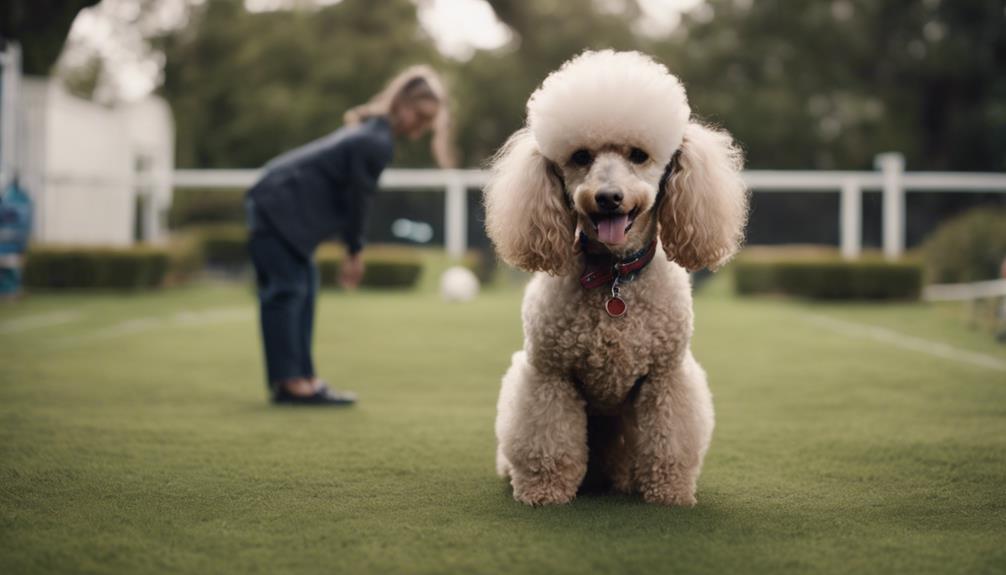If you're facing feisty dominance behavior in your Poodle, patience is paramount in navigating this nuanced issue. Understanding why your Poodle is displaying dominant tendencies can be the key to curbing them effectively. Stay tuned to discover practical tips and strategies that can help you establish a balanced and respectful relationship with your furry companion.
Key Takeaways
- Recognize signs like resource guarding and stiff body posture for addressing dominance.
- Use positive reinforcement and consistent training to manage dominant behavior effectively.
- Address psychological triggers with behavioral therapy tailored to the Poodle's personality.
- Foster a strong bond through positive interactions to prevent and manage dominance in Poodles.
Understanding Dominance Behavior in Poodles

When observing your Poodle, it is crucial to recognize the signs of dominance behavior to understand their mindset and address any potential issues effectively. Dominance behavior in Poodles can manifest through actions like resource guarding, pushy behavior, and resistance to handling. These behaviors are often accompanied by signs such as stiff body posture, direct eye contact, and raised fur. Factors like socialization, training, and pack dynamics play a role in shaping dominance in Poodles.
To address dominance behavior in your Poodle, consistent training is essential. By establishing clear leadership and setting boundaries, you can create a harmonious relationship with your pet. Positive reinforcement and obedience training are effective strategies for managing dominance behavior. However, if you encounter difficulties, do not hesitate to seek professional help. A professional can provide guidance tailored to your Poodle's specific needs and help you navigate any challenges that may arise. Remember, understanding and addressing dominance behavior in your Poodle is key to fostering a healthy and balanced relationship.
Recognizing Dominant Behaviors in Poodles

Recognizing dominant behaviors in Poodles involves observing their interactions and body language for key indicators of assertive or controlling tendencies. When dealing with a potentially dominant Poodle, keep an eye out for the following signs:
- Refusal to follow commands or comply with requests.
- Attempting to control access to certain spaces or resources.
- Showing possessiveness over toys or food.
These behaviors can indicate underlying dominance issues that need to be addressed. Dominant Poodles may also exhibit stiff body posture, direct eye contact, or raised fur along their back as further indicators of their dominant behavior. Understanding territorial aggression in Poodles is crucial for recognizing behaviors such as excessive marking, aggressive barking at strangers near the home, or defending boundaries vigorously. Moreover, identifying resistance to handling in Poodles, like growling during grooming or snapping when touched in specific areas, can also signal dominance problems that require attention. By being attentive to these signs, you can better address and manage dominant behaviors in your Poodle effectively.
Factors Influencing Dominant Behavior in Poodles

Factors influencing dominant behavior in Poodles can stem from a combination of genetic predispositions, environmental stimuli, and past experiences. Poodles, like all dogs, have a range of behaviors influenced by various factors. Understanding these influences is crucial in addressing and modifying dominant behaviors in your Poodle.
| Factors Influencing Dominant Behavior in Poodles | Examples |
|---|---|
| Genetic Predispositions | Some Poodles may inherit assertive traits from their lineage. |
| Environmental Stimuli | Lack of socialization or inconsistent training can trigger dominance. |
| Past Experiences | Negative encounters or trauma can shape dominant behavior. |
Recognizing that dominant behavior in Poodles can be a result of these factors enables you to tailor interventions effectively. By focusing on socialization, consistent training, and creating a positive environment, you can help your Poodle develop healthier behaviors. Acknowledging the complexity of dog behavior and the impact of their environment is the first step in addressing dominance in Poodles.
Managing Dominant Behavior in Poodles
To effectively manage dominant behavior in your Poodle, focus on setting clear boundaries, adopting a consistent leadership approach, and utilizing positive reinforcement training techniques. Consistency in your interactions, along with clearly communicated expectations, can help establish your role as the leader in the relationship. By reinforcing desired behaviors and addressing any signs of dominance promptly, you can create a harmonious environment for you and your Poodle.
Setting Clear Boundaries
Establishing clear boundaries with consistent rules is imperative when addressing dominant behavior in Poodles. To effectively manage dominant tendencies in your Poodle, consider the following key points:
- Consistent Rules: Enforce a set of rules consistently to show your Poodle what behaviors are acceptable.
- Leadership and Guidance: Provide strong leadership and guidance to prevent your Poodle from assuming a dominant role in your household.
- Limit Undesirable Behaviors: Set limitations on actions like begging, demanding attention, or resource guarding to correct dominant tendencies.
Consistent Leadership Approach
When guiding your Poodle towards better behavior, maintaining a consistent leadership approach is key for effectively managing dominance tendencies. Poodles respond well to a clear pack leader, so establishing yourself in this role is crucial to prevent dominant behaviors. These intelligent dogs thrive on structure and routine, making consistent leadership essential for their well-being. By using positive reinforcement and reward-based training techniques, you can reinforce your position as the leader and guide your Poodle towards more balanced behavior. Addressing any signs of dominance early and consistently will help shape a well-mannered and respectful companion. Remember, your Poodle looks to you for guidance, so staying consistent and firm in your leadership will yield positive results.
Consistent Leadership Approach Table:
| Key Points | Description | Benefits |
|---|---|---|
| Clear Rules & Boundaries | Establishing rules and boundaries helps your Poodle understand expectations and reduces dominant behavior. | Promotes respect and a harmonious relationship. |
| Establishing Pack Leader | Positioning yourself as the pack leader instills confidence in your Poodle and reduces the need for dominance. | Builds trust and a sense of security. |
| Positive Reinforcement | Using rewards for good behavior reinforces your leadership role positively. | Creates a bond based on trust and cooperation. |
| Early Consistent Training | Consistent training from the start helps prevent dominance issues before they escalate. | Sets a foundation for long-term obedience. |
Positive Reinforcement Training
Utilizing positive reinforcement techniques is a proactive and effective approach for managing dominant behavior in Poodles. This training method focuses on rewarding desired behaviors in Poodles with treats, praise, or toys, encouraging good behavior rather than punishing unwanted actions. Consistent use of positive reinforcement helps reinforce obedience and respect in your Poodle, fostering a strong bond between you and your furry companion. By promoting positive interactions and reinforcing desired actions, positive reinforcement training proves to be an effective way of managing dominant behavior in Poodles. Remember, building a respectful and obedient relationship with your Poodle through positive reinforcement will lead to a happier and healthier bond between you both.
Psychological Causes and Treatment for Poodles

When addressing dominance behavior in Poodles, understanding the psychological triggers is crucial. Identifying the root causes and utilizing behavioral therapy can help modify your Poodle's behavior effectively. Employing positive reinforcement techniques can aid in reshaping their responses and fostering a harmonious relationship.
Poodle Dominance Triggers
Addressing dominance triggers in Poodles requires a deep understanding of the psychological causes behind their behavior and the appropriate treatment methods to effectively manage and modify their conduct. Poodles may exhibit dominance triggers such as resource guarding, attention-seeking behavior, and refusal to follow commands due to underlying issues like anxiety or insecurity. To help your Poodle overcome these challenges, consider the following:
- Recognize signs of resource guarding and implement strategies to prevent it.
- Address attention-seeking behaviors by providing mental stimulation and structured interactions.
- Work on improving response to commands through consistent positive reinforcement training.
Understanding and actively working on these triggers can significantly improve your Poodle's behavior and overall well-being.
Behavioral Therapy Options
To effectively address dominance behavior in Poodles, understanding the underlying psychological causes and implementing tailored behavioral therapy options is crucial. Behavioral therapy for dominance in Poodles involves addressing psychological factors such as fear, anxiety, or insecurity that may be triggering the dominant behaviors. Treatment options often include behavior modification techniques, positive reinforcement, and desensitization to help reduce instances of dominance. Obedience training, socialization, and structured routines can also be beneficial in establishing a balanced relationship with your Poodle. Consulting a professional behaviorist specialized in dog behavior can provide valuable insights and assist in creating a personalized behavioral therapy plan to effectively address dominance issues. Remember, understanding your Poodle's individual personality and triggers is key to successful psychological treatment for dominance behavior.
Positive Reinforcement Techniques
To effectively address dominance behavior in Poodles, embracing positive reinforcement techniques tailored to their psychological causes is paramount. Positive reinforcement techniques involve rewarding desired behaviors in Poodles with treats, praise, or toys, helping to reinforce good behaviors and discourage dominant behaviors. Consistent use of positive reinforcement can create a strong bond and trust between you and your Poodle, promoting a positive learning environment. By focusing on positive behaviors, Poodles learn to associate good conduct with rewards, shaping their behavior positively without the need for harsh punishment. Remember, utilizing positive reinforcement techniques can not only address dominant behaviors but also strengthen the bond between you and your furry companion.
Dealing With Separation Anxiety in Poodles

Dealing with separation anxiety in Poodles requires understanding their strong bond with owners and implementing effective strategies to alleviate symptoms and prevent related dominance behaviors. Poodles, known for their loyalty, can exhibit signs of distress when separated from their owners, such as excessive barking, destructive behavior, and house soiling. This anxiety can escalate into dominance behaviors as a coping mechanism. To address separation anxiety in Poodles, training plays a crucial role. Positive reinforcement techniques, desensitization to departures, and creating a safe space can help ease their distress. Additionally, mental stimulation through interactive toys or puzzles can keep Poodles engaged and mentally active when alone. By tackling separation anxiety, you not only improve your Poodle's well-being but also reduce the likelihood of dominance issues arising. Understanding and addressing their emotional needs is key to fostering a harmonious relationship with your beloved Poodle.
Addressing Dominance Aggression in Poodles
When addressing dominance aggression in Poodles, a key aspect to focus on is their need for consistent training techniques emphasizing positive reinforcement and clear leadership. Poodles, known for their intelligence, can exhibit dominance aggression through behaviors like resource guarding, disobedience, or challenging actions towards family members. To effectively manage this behavior, consider the following:
- Implement training techniques centered around positive reinforcement to encourage desired behaviors.
- Maintain consistency in enforcing rules, setting boundaries, and providing mental stimulation to address dominance aggression effectively.
- Seek guidance from a professional dog trainer or behaviorist who specializes in working with Poodles to develop a tailored plan for correcting dominance aggression.
Frequently Asked Questions
How Do You Fix a Dog's Dominance Behavior?
To fix a dog's dominance behavior, focus on positive reinforcement, consistent training, behavior modification, establishing boundaries, assuming a leadership role, and building trust. Seek professional guidance for tailored assistance in managing and correcting dominance issues effectively.
How Do You Tell if a Dog Is Trying to Dominate You?
To tell if a dog is trying to dominate you, watch for signs like ignoring commands, invading space, demanding attention, growling, snapping, or resource guarding. Establish boundaries, set rules, provide structure, and use consistent training with positive reinforcement.
What Is a Dominant Dog's Body Language?
When a dog displays dominance, their body language may include assertive posture, direct eye contact, raised hackles, stiff body language, intense staring, and aggressive gestures. Understanding these signals can help you address and manage dominance behaviors.
How Do You Socialize a Dominant Dog?
To socialize a dominant dog effectively, focus on positive reinforcement, obedience training, and consistent boundaries. Incorporate play therapy to encourage respectful interactions. Establish a clear pack structure and assume a leadership role to guide your dog towards appropriate behavior.
Conclusion
As you navigate the complex world of dominance behavior in Poodles, remember that you are the captain of your ship. Just as a skilled sailor guides their vessel through turbulent waters, you must steer your Poodle towards obedience and respect. With patience, consistency, and a firm hand on the helm, you can navigate through any behavioral challenges and emerge with a stronger bond with your furry first mate.